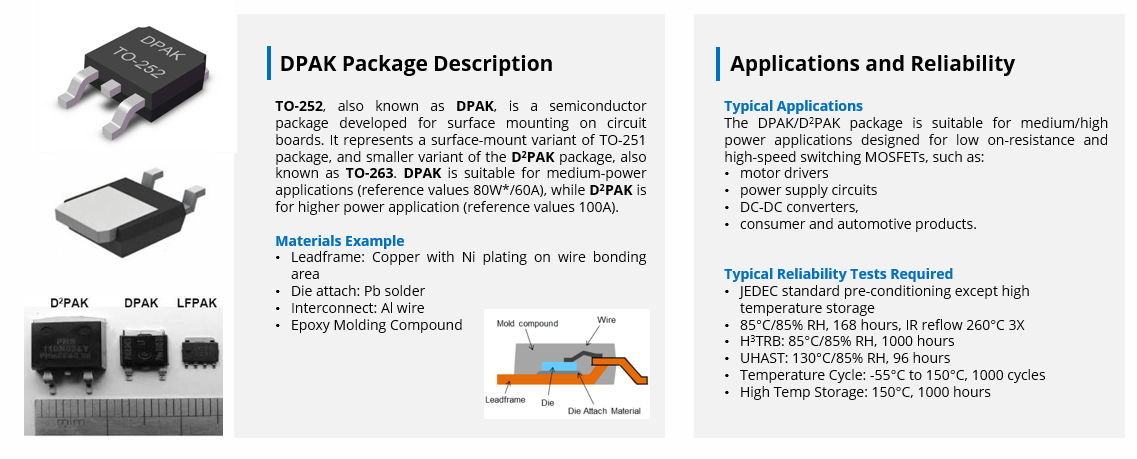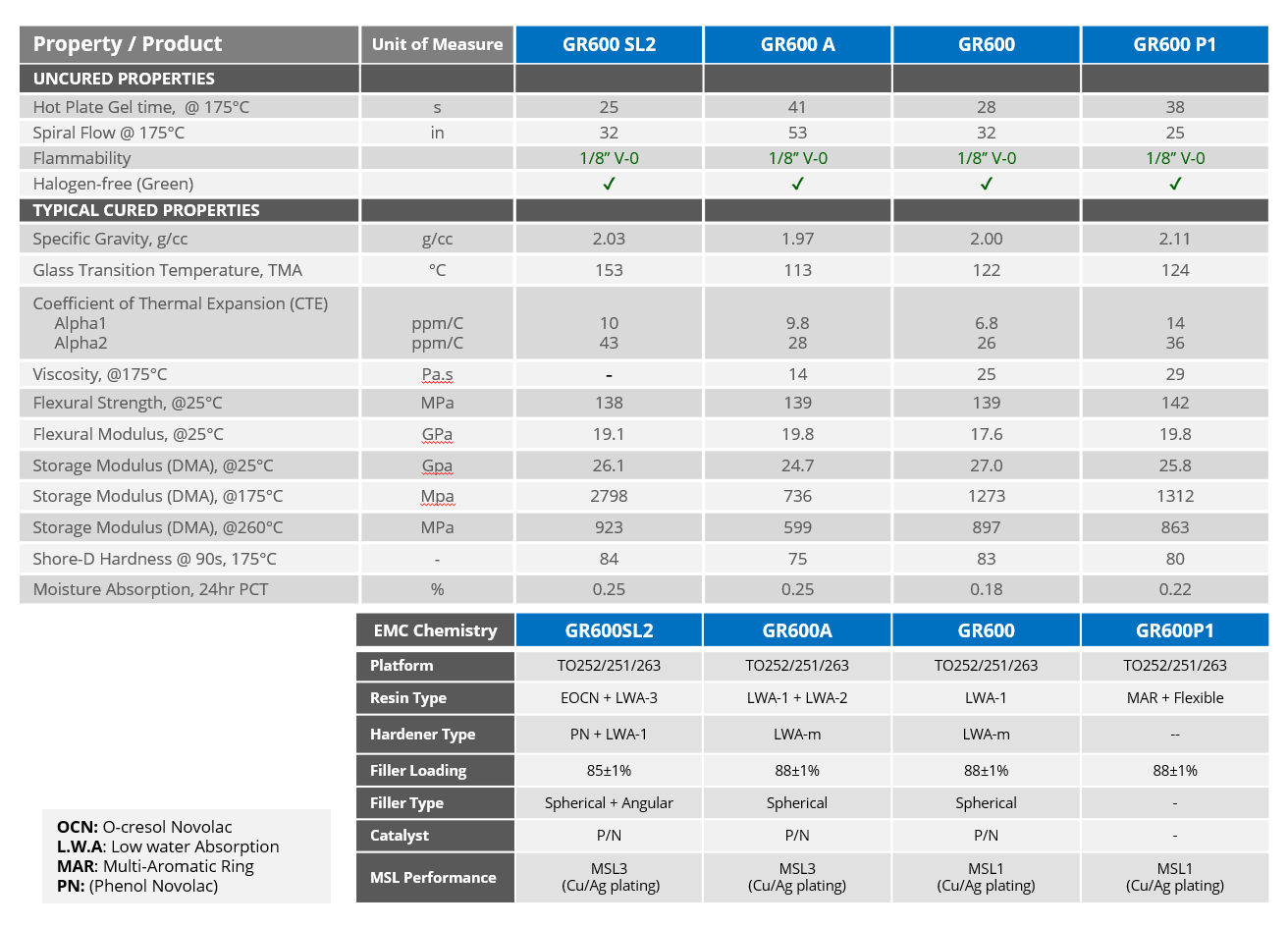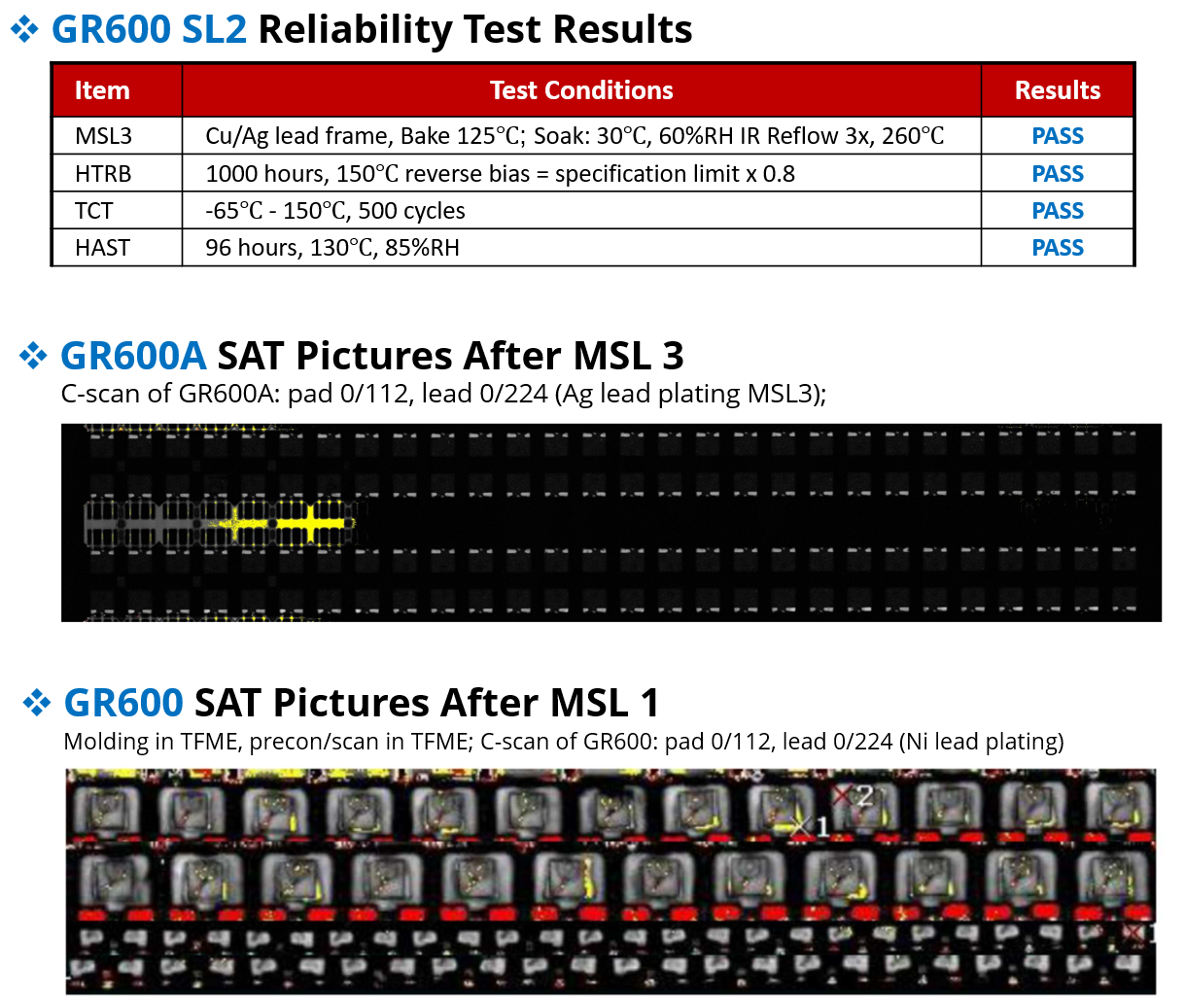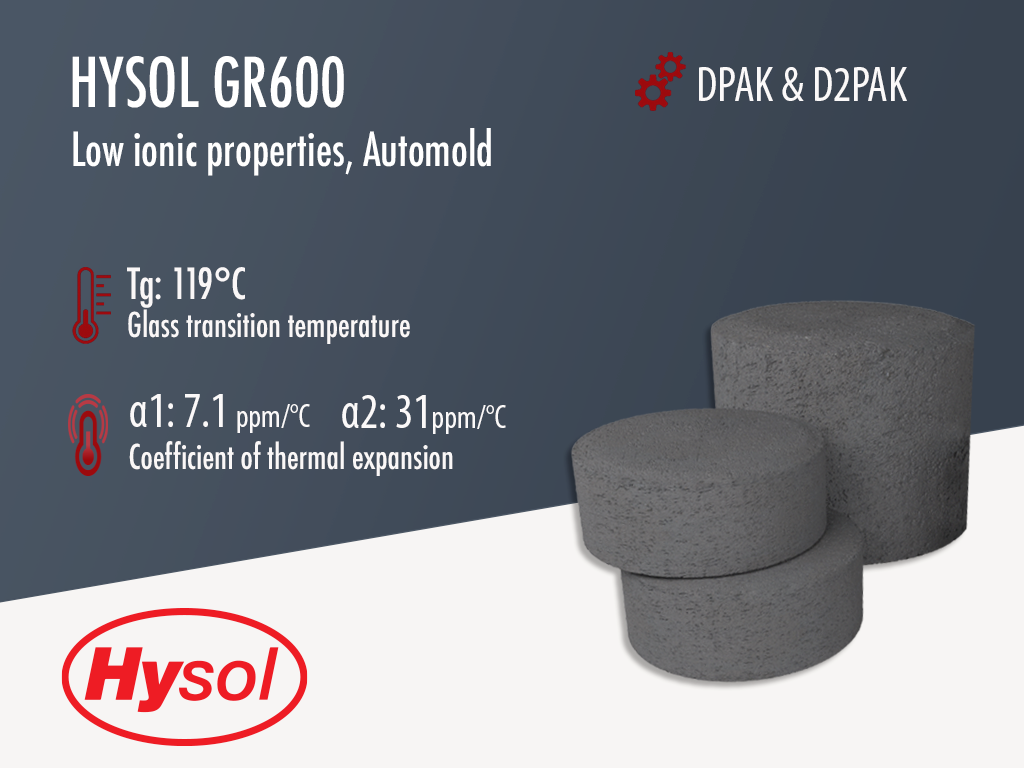Hysol GR600-P1 | Black Epoxy Mold Compound
- Designed for DPAK (TO252) & D2PAK
- MSL1 Capable on Ni-plating
- Excellent thermal cycle performance
Product Description
Hysol GR600 Series is a black semiconductor-grade epoxy molding compound designed for the encapsulation and protection of power discrete semiconductor packages. It is designed with DPAK, D2PAK, TO220 and TO252 in mind. Once molded and post-mold cured, this product provides optimum protection and reliability for these capacitor devices. It is laser markable with low ionic properties that help achieve an excellent thermal cycling performance.
Hysol GR600 is an environmentally "green" product, meaning that it doesn't contain any halogens including bromine, antimony or phosphorus flame retardants. This material is designed to achieve JEDEC Level 1 requirements at 260°C reflow temperature on DPAK and D2PAK packages. Its fast cure time also ensures that it is compatible with the latest automold manufacturing equipment. Hysol GR600 meets UL 94 V-0 Flammability at 1/8 inch thickness. Key features are summarized as:
Reliability (Check Test Results)
- High adhesion to Cu/Ag/Ni
- Low stress and low water absorption
- Excellent MSL3/MSL1 delamination performance
- Excellent performance in HAST, HTRB, TC, PCT, HTS, etc.
Moldability
- Excellent workability with wide process window
- Excellent cosmetic performance
- Good flash control
- Suitable for conventional/MGP mold
Available versions: GR600, GR600P1, GR600SL2, GR600A (Check the GR600 series comparison)
Suitable Package: TO251 (IPAK), TO-252 (DPAK), TO-263 (D2PAK) (Check the D2PAK packaging general requirements)
Technical Specifications
| General Properties | |||||||||
| Color Color The color | Black | ||||||||
| Filler Content | 88 % | ||||||||
| Specific Gravity Specific Gravity Specific gravity (SG) is the ratio of the density of a substance to the density of a reference substance; equivalently, it is the ratio of the mass of a substance to the mass of a reference substance for the same given volume. For liquids, the reference substance is almost always water (1), while for gases, it is air (1.18) at room temperature. Specific gravity is unitless. | 2.00 | ||||||||
| |||||||||
| Physical Properties | |||||||||
| Spiral Flow @ 175°C | 34 cm | ||||||||
| Chemical Properties | |||||||||
| |||||||||
| Moisture absorption | 0.20 % | ||||||||
| Electrical Properties | |||||||||
| |||||||||
| Volume Resistivity Volume Resistivity Volume resistivity, also called volume resistance, bulk resistance or bulk resistivity is a thickness dependent measurement of the resistivity of a material perpendicular to the plane of the surface. | 5.6x1016 Ohms⋅cm | ||||||||
| Mechanical Properties | |||||||||
| |||||||||
| |||||||||
| |||||||||
| Molded Shrinkage | TBD % | ||||||||
| |||||||||
| Thermal Properties | |||||||||
| |||||||||
| |||||||||
| Glass Transition Temperature (Tg) Glass Transition Temperature (Tg) The glass transition temperature for organic adhesives is a temperature region where the polymers change from glassy and brittle to soft and rubbery. Increasing the temperature further continues the softening process as the viscosity drops too. Temperatures between the glass transition temperature and below the decomposition point of the adhesive are the best region for bonding. The glass-transition temperature Tg of a material characterizes the range of temperatures over which this glass transition occurs. | 119 °C | ||||||||
| UL 94 Rating UL 94 Rating Flammability rating classification. It determines how fast a material burns or extinguishes once it is ignited. HB: slow burning on a horizontal specimen; burning rate less than 76 mm/min for thickness less than 3 mm or burning stops before 100 mm V-2: burning stops within 30 seconds on a vertical specimen; drips of flaming particles are allowed. V-1: burning stops within 30 seconds on a vertical specimen; drips of particles allowed as long as they are not inflamed. V-0: burning stops within 10 seconds on a vertical specimen; drips of particles allowed as long as they are not inflamed. 5VB: burning stops within 60 seconds on a vertical specimen; no drips allowed; plaque specimens may develop a hole. 5VA: burning stops within 60 seconds on a vertical specimen; no drips allowed; plaque specimens may not develop a hole | V0 | ||||||||
| Curing Conditions | |||||||||
| |||||||||
| |||||||||
| Transfer Pressure | 40 - 150 kg/cm2 | ||||||||
| Transfer Time | 5 - 15 s | ||||||||
Additional Information
Designed for DPAK (TO252) & D2PAK (TO262) Power Discrete Packages
DPAK and D2PAK are power discrete semiconductor packages that are not easy to mold. The package geometry is not very difficult, but once molded, these devices need to be tested under BIAS before and after both humidity exposure and thermal cycling. This test is called the High Temperature Reverse Bias (HTRB) testing and is where most semiconductor epoxy mold compounds fail. Once biased, the device experience "gate leakage" and then fail catastrophically. Furthermore, most DPAK and D2PAK packages are often built using a Nickel (Ni) plating. Nickel is notoriously difficult to adhere to and as such make it difficult to pass high MSL performance levels. DPAK and D2PAK packages are still mature products and as such, the products used to mold them must be cost-competitive. The GR600 EMC is the first product in a series designed to meet all these criteria.

GR600 Series Products Comparison

GR600 Series Reliability Test Results At Customer Sites

Caplinq Cool Supply Chain For GR600 Products




